Comparison of Leaf Area Index, Surface Temperature, and Actual Evapotranspiration Estimated Using the METRIC Model and In Situ Measurements
Abstract
:1. Introduction
2. Material and Methods
2.1. Experimental Area
2.2. Landsat Images
2.3. METRIC Model
2.4. Meteorological Data
2.5. In Situ Measurements
2.5.1. Leaf Area Index Measured with AccuPAR
2.5.2. Surface Temperature Measured with Infrared Thermometer
2.5.3. Actual Evapotranspiration Estimated with an Atmometer
2.5.4. Soil Moisture Measured with Soil Moisture Sensors
2.6. Statistical Analysis between the METRIC Model and in situ Measurements
3. Results and Discussion
3.1. Precipitation and Soil Water Content
3.2. LAI Maps, Comparison and Relationship of LAI with the METRIC Model and AccuPAR
3.3. Ts Maps, Comparison and Relationship of Surface Temperature between METRIC and Infrared Thermometer
3.4. ETa Maps, Crop Coefficient, Comparison and Relationship of ETa between METRIC and Atmometer
4. Conclusions
Author Contributions
Acknowledgments
Conflicts of Interest
References
- ASCE-EWRI. The ASCE Standardized Reference Evapotranspiration Equation. Report of the ASCE-EWRI Task Committee on Standardization of Reference Evapotranspiration; ASCE: Reston, VA, USA, 2005; p. 147. [Google Scholar]
- Allen, R.G.; Tasumi, M.; Trezza, R. Satellite-based energy balance for mapping evapotranspiration with internalized calibration (METRIC)-Model. J. Irrig. Drain. Eng. ASCE 2007, 4, 380–394. [Google Scholar] [CrossRef]
- Gowda, P.H.; Chavez, J.L.; Colaizzi, P.D.; Evett, S.R.; Howell, T.A.; Tolk, J.A. Remote sensing based energy balance algorithms for mapping ET: Current and future challenges. Trans ASABE 2007, 50, 1639–1644. [Google Scholar] [CrossRef]
- Allen, R.G.; Tasumi, M.; Morse, A.; Trezza, R.; Wright, J.L.; Bastiaansen, W.; Kramber, W.; Lorite, I.; Robinson, C.W. Satellite-based energy balance for mapping evapotranspiration with internalized calibration (METRIC)-Applications. J. Irrig. Drain. Eng. ASCE 2007, 4, 395–406. [Google Scholar] [CrossRef]
- Anderson, M.C.; Kustas, W.P.; Norman, J.M.; Hain, C.R.; Mecikalski, J.R.; Schultz, L.; Gonzalez-Dugo, M.P.; Cammalleri, C.; d’Urso, G.; Pimstein, A.; et al. Mapping daily evapotranspiration at field to continental scale using geostationary and polar orbiting satellite imagery. Hydrol. Earth Syst. Sci. 2011, 15, 223–239. [Google Scholar] [CrossRef]
- Jones, H.G.; Vaughan, R.A. Remote Sensing of Vegetation: Principles, Techniques, and Applications; 1st ed.; Oxford University Press: Oxford, UK, 2010; p. 353. [Google Scholar]
- Qu, Y.; Zhu, Y.; Han, W.; Wang, J.; Ma, M. Crop leaf area index observations with a wireless sensor network and its potential for validating remote sensing products. IEEE J. Sel. Top. Appl. Earth Obs. Remote Sens. 2014, 7, 431–444. [Google Scholar] [CrossRef]
- Allen, R.G.; Morton, C.; Kamble, B.; Kilic, A.; Huntington, J.; Thau, D.; Gorelick, N.; Erickson, T.; Moore, R.; Trezza, R.; et al. EEFlux: A Landsat-based evapotranspiration mapping tool on the Google Earth Engine. Am. Soc. Agric. Biol. Eng. 2015, 1–11. [Google Scholar] [CrossRef]
- Asner, G.; Scurlock, J.M.O.; Hicke, J.A. Global synthesis of leaf area index observations: Implications for ecological and remote sensing studies. Glob. Ecol. Biogeogr. 2003, 12, 191–205. [Google Scholar] [CrossRef]
- Gao, S.; Niu, Z.; Huang, N.; Hou, X. Estimating the leaf area index, height and biomass of maize using Hj-1 and RADARSAT-2. Int. J. Appl. Earth Obs. Geoinform. 2013, 24, 1–8. [Google Scholar] [CrossRef]
- Gowda, P.H.; Howell, T.A.; Chavez, J.L.; Paul, G.; Moorhead, J.E.; Holman, D.; Marek, T.H.; Porter, D.O.; Marek, G.H.; Colaizzi, P.D.; et al. A decade of remote sensing and evapotranspiration research at USDA_ARS conservation and production research laboratory. In Proceedings of the Emerging technologies for sustainable irrigation a join ASABE/IA Irrigation Symposium, Long Beach, CA, USA, 10–12 November 2015. [Google Scholar]
- Colombo, R.; Bellingeri, D.; Fasolini, D.; Marino, C.M. Retrieval of leaf area index in different vegetation types using high resolution satellite data. Remote Sens. Environ. 2003, 86, 120–131. [Google Scholar] [CrossRef]
- Nguy-Robertson, A.; Gitelson, A.; Peng, Y.; Viña, A.; Arkebauer, T.; Rundquist, D. Green leaf index estimation in maize and soybean: Combining vegetation indices to achieve maximal sensitivity. Agron. J. 2012, 104, 1336–1347. [Google Scholar] [CrossRef]
- Zipper, S.; Loheidi II, S.P. Using evapotranspiration to assess drought sensitivity on a subfield scale with HRMET, a high resolution surface energy balance model. Agric. For. Meteorol. 2014, 197, 91–102. [Google Scholar] [CrossRef]
- Tang, R.; Li, Z.-L.; Jia, Y.; Li, Ch.; Sun, X.; Kustas, W.P.; Anderson, M.C. An intercomparison of three remote sensing-based energy balance models using large aperture scintillometer measurement over a wheat-corn production region. Remote. Sens. Environ. 2011, 115, 3187–3202. [Google Scholar] [CrossRef]
- Hosseini, M.; McNairn, H.; Merzouki, A.; Pacheco, A. Estimation of leaf area index (LAI) in corn and soybean using multi-polarization C- and L-band radar data. Remote Sens. Environ. 2015, 170, 77–89. [Google Scholar] [CrossRef]
- Liang, L.; Di, L.; Zhang, L.; Deng, M.; Qin, Z.; Zhao, S.; Lin, H. Estimation of crop LAI using hyperspectral indices and a hybrid inversion method. Remote Sens. Environ. 2015, 165, 123–134. [Google Scholar] [CrossRef]
- Irmak, S.; Haman, D.Z.; Bastug, R. Determination of crop water stress index for irrigation timing and yield estimation of corn. Agron. J. 2000, 92, 1221–1227. [Google Scholar] [CrossRef]
- Lopez-Lopez, R.; Ramirez, T.A.; Sanchez-Cohen, I.; Bustamante, W.O.; Gonzalez-Lauck, V. Evapotranspiration and crop water stress index in mexican husk tomatoes (physalis ixocarpa brot). In Evapotranspiration from Measurements to Agricultural and Environmental Applications; In Tech: Jiutepec, Mexico, 2011. [Google Scholar]
- Taghvaeian, S.; Chávez, J.L.; Altenhofen, J.; Trouth, T.; DeJonge, K. Remote sensing for evaluating crop water stress at field scale using infrared thermography: Potential and limitations. Hydrol. Days 2013, 4, 74–83. [Google Scholar]
- Peters, R.T.; Evett, S.R. Automation of a center pivot using the temperature-time-threshold method of irrigation scheduling. J. Irrig. Drain. Eng. ASCE 2008, 134, 286–291. [Google Scholar] [CrossRef]
- O’Shaughnessy, S.A.; Evett, S.R. Canopy temperature based system effectively schedules and controls center pivot irrigation cotton. Agric. Water Manag. 2010, 97, 1310–1316. [Google Scholar] [CrossRef]
- Berni, J.J.A.; Zarco-Tejada, P.; Suarez, L.; Fereres, E. Thermal and narrowband multispectral remote sensing for vegetation monitoring form an unmanned aerial vehicle. IEEE Trans. Geosci. Remote Sens. 2009, 47, 722–738. [Google Scholar] [CrossRef]
- Bellvert, J.; Zarco-Tejada, P.J.; Girona, J.; Fereres, E. Mapping crop water stress index a pinot-noir vineyard: Comparing ground measurements with thermal remote sensing imagery from an unmanned aerial vehicle. Prec. Agric. 2014, 15, 361–376. [Google Scholar] [CrossRef]
- Ortega-Farias, S.; Ortega-Salazar, S.; Poblete, T.; Kilic, A.; Allen, R.; Poblete-Echeverria, C.; Ahumada-Orellana, L.; Zuñiga, M.; Sepúlveda, D. Estimation of energy balance components over a drip-irrigated olive orchard using thermal and multispectral cameras placed on a helicopter-based unmanned aerial vehicle (UAV). Remote Sens. 2016, 8, 638. [Google Scholar] [CrossRef]
- Sepúlveda-Reyes, D.; Ingram, B.; Bardeen, M.; Zuñiga, M.; Ortega-Farias, S.; Poblete-Echeverria, C. Selecting canopy zones and thresholding approaches to assess grapevine water status by using aerial and ground-based thermal imaging. Remote Sens. 2016, 8, 822. [Google Scholar] [CrossRef]
- Alchanatis, V.; Cohen, Y.; Cohen, S.; Moller, M.; Sprinstin, M.; Meron, M.; Tsipris, J.; Saranga, Y.; Sela, E. Evaluation of different approaches for estimating and mapping crop water status in cotton with thermal imaging. Prec. Agric. 2010, 11, 27–41. [Google Scholar] [CrossRef]
- Cohen, Y.; Alchanatis, V.; Sela, E.; Saranga, Y.; Cohen, S.; Meron, M.; Bosak, A.; Tsipris, J.; Ostrovsky, V.; Orolov, V.; et al. Crop water status estimation using thermography: Multi-year model development using ground-based thermal images. Prec. Agric. 2015, 16, 311–329. [Google Scholar] [CrossRef]
- Anderson, M.; Kustas, W. Thermal remote sensing of drought and evapotranspiration. EOS Trans. Am. Geophys. Union 2008, 89, 233–234. [Google Scholar] [CrossRef]
- Senay, G.B.; Friedrichs, M.; Singh, R.K.; Velpuri, N.M. Evaluating Landsat 8 evapotranspiration for water use mapping in the Colorado river basin. Remote Sens. Environ. 2016, 185, 171–185. [Google Scholar] [CrossRef]
- Kjaersgaard, J.; Allen, R.G.; Irmak, A. Improved methods for estimating monthly and growing season ET using METRIC applied to moderate resolution satellite imagery. Hydrol. Process. 2011, 25, 4028–4036. [Google Scholar] [CrossRef]
- Chávez, J.L.; Gowda, P.H.; Evett, S.R.; Colaizzi, P.D.; Howell, T.A.; Marek, T. An application METRIC for ET mapping in the Texas High Plains. In Proceedings of the ASABE annual international meeting, Minneapolis, MN, USA, 17–20 June 2007. [Google Scholar]
- Hankerson, B.; Kjaersgaard, J.; Hay, C. Estimation evapotranspiration from fields with and without cover crops using remote sensing and in situ methods. Remote Sens. 2012, 4, 3796–3812. [Google Scholar] [CrossRef]
- Carrasco-Benavides, M.; Ortega-Farias, S.; Lagos, L.O.; Kleissl, J.; Morales-Salinas, L.; Kilic, A. Parameterization of the satellite-based model (METRIC) for the estimation of instantaneous surface energy balance components over a drip-irrigated vineyard. Remote Sens. 2014, 6, 11342–11371. [Google Scholar] [CrossRef]
- Zhang, H.; Anderson, R.G.; Wang, D. Satellite-based crop coefficient and regional water use estimates for Hawaiian sugarcane. Field Crops Res. 2015, 180, 143–154. [Google Scholar] [CrossRef] [Green Version]
- Liebert, R.; Huntington, J.; Morton, C.; Sueki, S.; Acharya, K. Reduced evapotranspiration from leaf beetle induced tamarisk defoliation in the lower Virgin River using satellite-based energy balance. Ecohydrology 2015, 9, 179–193. [Google Scholar] [CrossRef]
- Mkhwanazi, M.M.; Chavez, J.L. Using METRIC to estimate surface energy fluxes over an alfalfa field in Eastern Colorado. Hydrol. Days 2012, 7, 90–98. [Google Scholar]
- Broner, I.; Law, R.A.P. Evaluation of a modified atmometer for estimating reference ET. Irrig. Sci. 1991, 12, 21–26. [Google Scholar] [CrossRef]
- Alam, M.; Trooien, T.P. Estimating reference evapotranspiration with an atmometer. Appl. Eng. Agric. 2001, 2, 153–158. [Google Scholar]
- Reyes-González, A.; Kjaersgaard, J.; Trooien, T.; Hay, C.; Ahiablame, L. Comparative Analysis of METRIC model and atmometer methods for estimating actual evapotranspiration. Int. J. Agron. 2017, 3632501. [Google Scholar] [CrossRef]
- Kjaersgaard, J.; Allen, R.G. Remote Sensing Technology to Produce Consumptive Water Use Maps for the Nebraska Panhandle, Final completion report submitted to the University of Nebraska. 2010; 60p.
- Allen, R.G.; Irmak, A.; Trezza, R.; Hendrickx, J.M.H.; Bastiaansssen, W.; Kjaersgaard, J. Satellite-based ET estimation in agriculture using SEBAL and METRIC. Hydrol. Process. 2011, 25, 4011–4027. [Google Scholar] [CrossRef]
- Bastiaanssen, W.G.M. Remote Sensing in Water Resources Management: The State of the Art; International Water Management Institute: Colombo, Sri Lanka, 1998; 118p. [Google Scholar]
- Tasumi, M. Progress in Operation Estimation of Regional Evapotranspiration Using Satellite Imagery. Ph.D. Thesis, University of Idaho, Moscow, ID, USA, 2003. [Google Scholar]
- Chander, G.; Markham, B.L.; Helder, D.L. Summary of current radiometric calibration coefficients for Landsat MSS, TM, ETM+ and EO-1 ALI sensors. Remote Sens. Environ. 2009, 113, 893–903. [Google Scholar] [CrossRef]
- Allen, R.G.; Pereira, L.S.; Raes, D.; Smith, M. Crop Evapotranspiration: Guide-Lines for Computing Crop Requirements. Irrigation and Drainage Paper No. 56; FAO: Rome, Italy, 1998. [Google Scholar]
- Stewart, C.W.; Costa, C.; Dwayer, LM.; Smith, D.L.; Hamilton, R.I.; Ma, B.L. Canopy structure, light interception, and photosynthesis in maize. Agron. J. 2003, 95, 1465–1474. [Google Scholar] [CrossRef]
- Jensen, M.E.; Allen, R.G. Evaporation, Evapotranspiration, and Irrigation Water Requirements. ASCE Manuals and Reports on Engineering Practice: No 70, 2nd ed.American Society of Civil Engineers: Reston, VA, USA, 2016; 744p. [Google Scholar]
- Martínez, B.; Garcia-Haro, F.J.; Camacho-de Coca, F. Derivation of high-resolution leaf area index maps support of validation activities: Application to the cropland Barrax site. Agric. For. Meteorol. 2009, 149, 130–145. [Google Scholar] [CrossRef]
- Igbadun, H.E.; Salim, B.A.; Tarimo, A.K.P.R.; Mahoo, H.F. Effects of deficit irrigation scheduling on yields and soil water balance of irrigated maize. Irrig. Sci. 2008, 27, 11–23. [Google Scholar] [CrossRef]
- Tewolde, H.; Sistani, K.R.; Rowe, D.E.; Adeli, A.; Tsegaye, T. Estimating cotton leaf area index nondestructively with a light sensor. Agron. J. 2005, 97, 1158–1163. [Google Scholar] [CrossRef]
- Gallardo, I.T. Using Infrared Canopy Temperature and Leaf Eater Potential for Irrigation Scheduling in Peppermint (Mentha piperita L.). Master’s Thesis, Oregon State University, Corvallis, OR, USA, 1993. [Google Scholar]
- Durigon, A.; Jong van Lier, Q. Canopy temperature versus soil water pressure head for the prediction of crop water stress. Agric. Water Manag. 2013, 127, 1–6. [Google Scholar] [CrossRef]
- Allen, R.G.; Kjaersgaard, J.; Garcia, M. Fine–tuning components of inverse-calibrated, thermal-based remote sensing models for evapotranspiration. In Proceedings of the Pecora 17-The future of land imaging…going operational, Denver, CO, USA, 18–20 November 2008. [Google Scholar]
- Han, M.; Zhang, H.; Dejonge, KC.; Comas, LH.; Trout, T.J. Estimating maize water stress by standard deviation of canopy temperature in thermal imagery. Agric. Water Manag. 2016, 177, 400–409. [Google Scholar] [CrossRef]
- Zia, S.; Sophrer, K.; Wenyong, D.; Spreer, W.; Romano, G.; Xiongkui, H.; Müller, J. Monitoring physiological responses to water stress in two maize varieties by infrared thermography. Int. J. Agric. Biol. Eng. 2011, 4, 7–15. [Google Scholar]
- Romano, G.; Zia, S.; Spreer, W.; Sanchez, C.; Cairns, J.; Araus, JL.; Muller, J. Use of thermography for high throughput phenotyping of tropical maize adaptation in water stress. Comput. Electron. Agric. 2011, 79, 67–74. [Google Scholar] [CrossRef]
- Neukam, D.; Ahrends, H.; Luig, A.; Manderscheid, R.; Kage, H. Integrating wheat canopy temperature in crop system models. Agronomy 2016, 6, 7. [Google Scholar] [CrossRef]
- Gowda, P.H.; Chávez, J.L.; Howell, T.A.; Marek, T.H.; New, L.L. Surface energy balance based evapotranspiration mapping in the Texas High Plains. Sensors 2008, 8, 5186–5201. [Google Scholar] [CrossRef] [PubMed]
- Santos, C.; Lorite, I.J.; Tasumi, M.; Allen, R.G.; Fereres, E. Integrating satellite-based evapotranspiration with simulation models for irrigation management at the scheme level. Irrig. Sci. 2008, 26, 277–288. [Google Scholar] [CrossRef]
- Choi, M.; Kim, T.W.; Park, M.; Kim, S.J. Evapotranspiration estimation using the Landsat-5 Thematic Mapper image over the Gyungan watershed in Korea. Int. J. Remote Sens. 2011, 32, 4327–4341. [Google Scholar] [CrossRef]
- Reyes-González, A.; Kjaersgaard, J.; Trooien, T.; Hay, C.; Ahiablame, L. Estimation of crop evapotranspiration using satellite remote sensing-based vegetation index. Adv. Meteorol. 2018, 2018, 4525021. [Google Scholar]
- Reyes-González, A.; Kjaersgaard, J.; Trooien, T.; Hay, C.; Ahiablame, L. Assessing accuracy of vegetation index method to estimate actual evapotranspiration. Earth Sci. 2018, 7, 227–235. [Google Scholar] [CrossRef]
- Chen, F.; Robinson, P.J. Estimating reference crop evapotranspiration with ETgages. J. Irrig. Drain. Eng. ASCE 2009, 135, 335–342. [Google Scholar] [CrossRef]
- Gleason, D.; Andales, A.; Bauder, T.; Chávez, J. Performance of atmometers in estimating reference evapotranspiration in a semi-arid environment. Agric. Water Manag. 2013, 130, 27–35. [Google Scholar] [CrossRef]
- Peterson, K.; Bremer, D.; Fry, J. Evaluation of Atmometers within Urban Home Lawn Microclimates. Crop Sci. 2015, 55, 2359–2367. [Google Scholar] [CrossRef]
- Irmak, S.; Dukes, M.D.; Jacobs, J.M. Using modified Bellani plate evapotranspiration gauges to estimate short canopy reference evapotranspiration. J. Irrig. Drain. Eng. ASCE 2005, 2, 164–175. [Google Scholar] [CrossRef]
- Healey, N.C.; Irmak, A.; Arkebauer, T.J.; Billesbash, D.P.; Lenters, J.D.; Hubbard, K.G.; Allen, R.G.; Kjaersgaard, J. Remote sensing and in situ-based estimates of evapotranspiration for subirrigated meadow, dry valley, and upland dune ecosystems in the semi-arid sand hills of Nebraska, USA. Irrig. Drainage Syst. 2011, 25, 151–178. [Google Scholar] [CrossRef]
- Gordillo, V.M.; Flores, H.M.; Tijerina, L.; Arteaga, R. Estimacion de la evapotranspiracion utilizando un balance de energia e imagenes satelitales. Revista Mex. Cienc. Agríc. 2014, 1, 143–155. (In Spanish) [Google Scholar] [CrossRef]
- French, A.C.; Hunsaker, D.J.; Thorp, K.R. Remote sensing of evapotranspiration over cotton using the TSEB and METRIC energy balance model. Remote Sens. Environ. 2015, 158, 281–294. [Google Scholar] [CrossRef]
- Irmak, A.; Ratcliffe, I.; Ranade, P.; Hubbard, K.G.; Sing, R.K.; Kamble, B.; Kjaersgaard, J. Estimation of land surface evapotranspiration with a satellite remote sensing procedure. Great Plains Res. 2011, 21, 73–88. [Google Scholar]


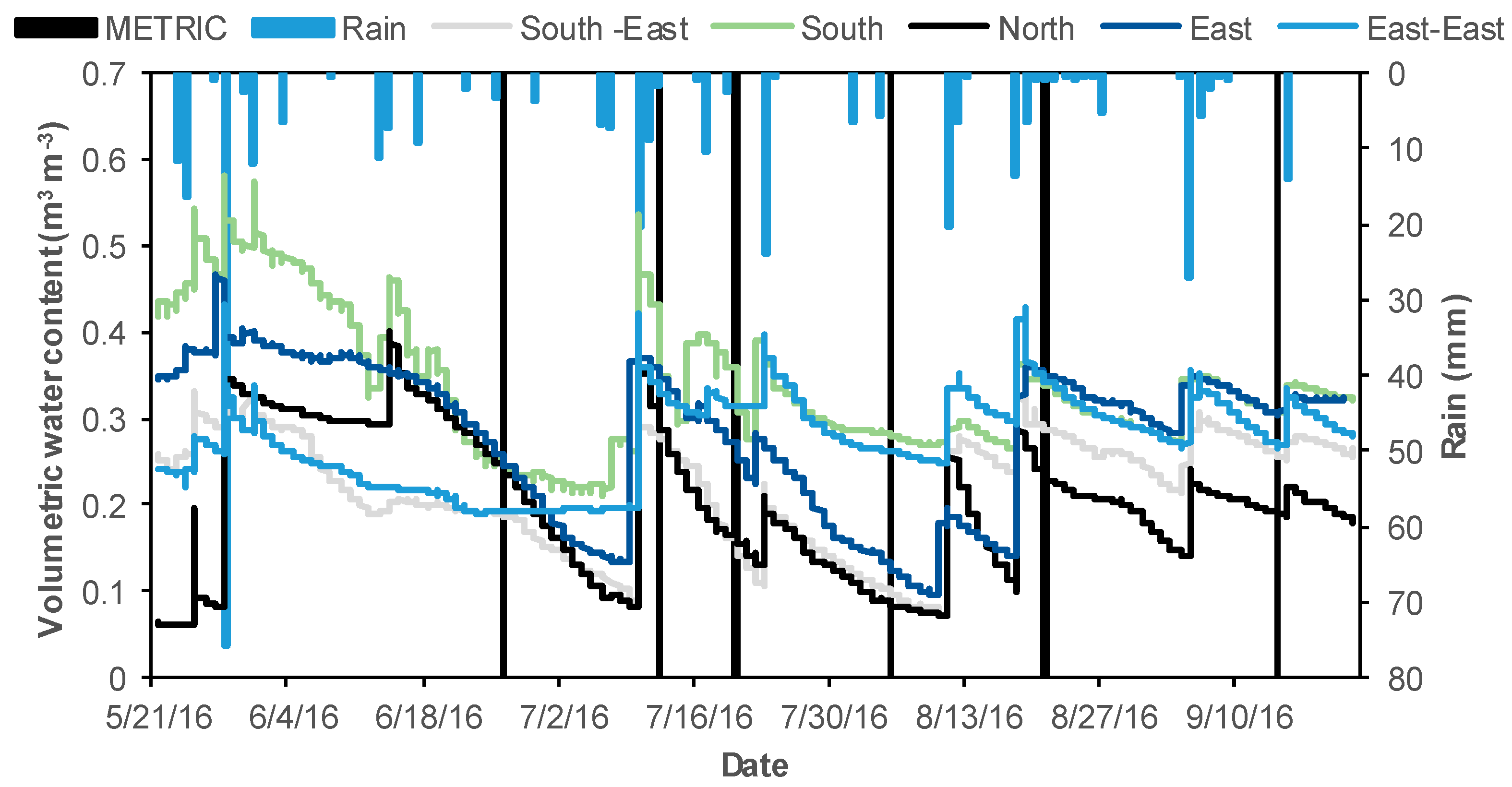

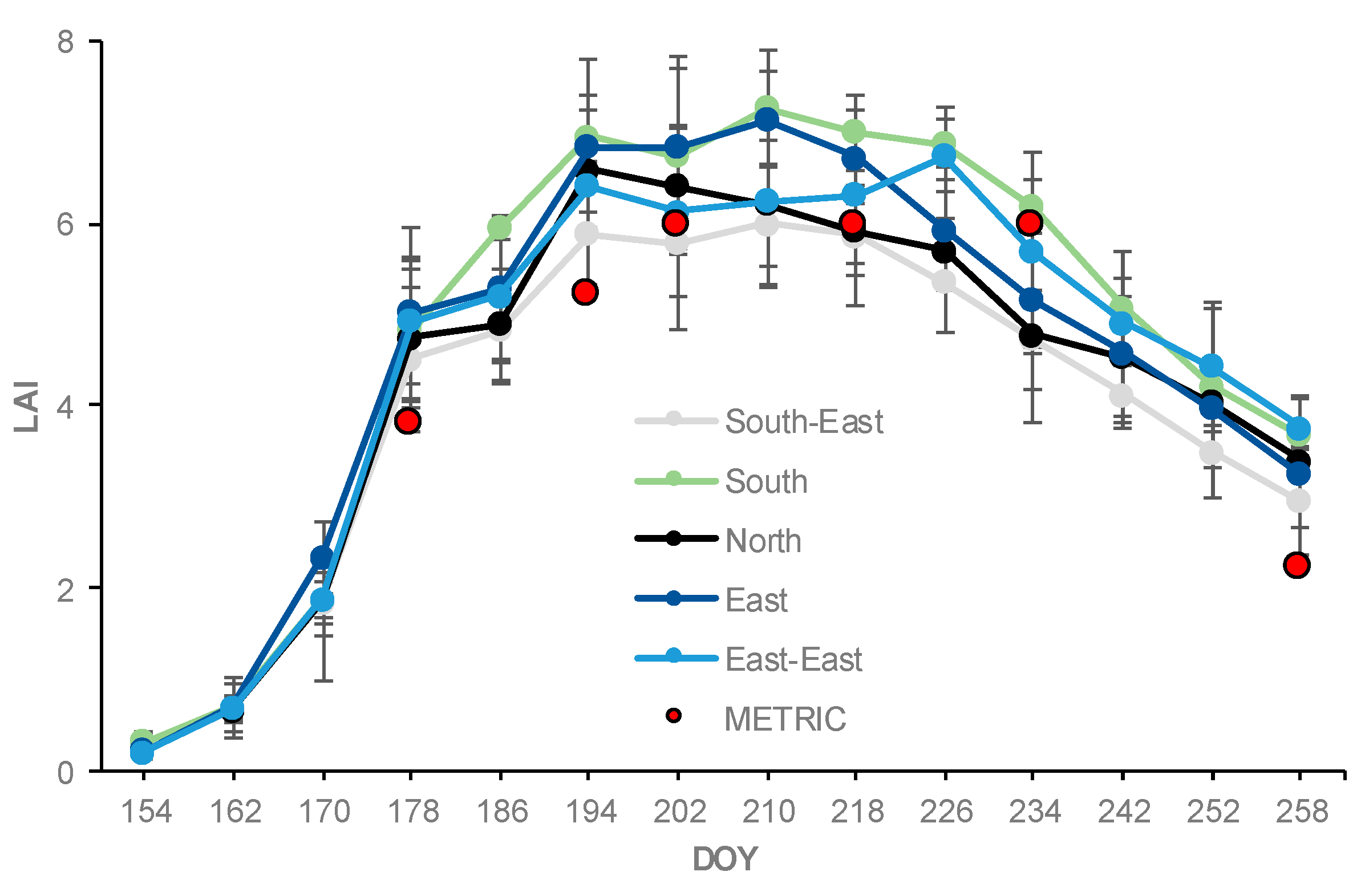
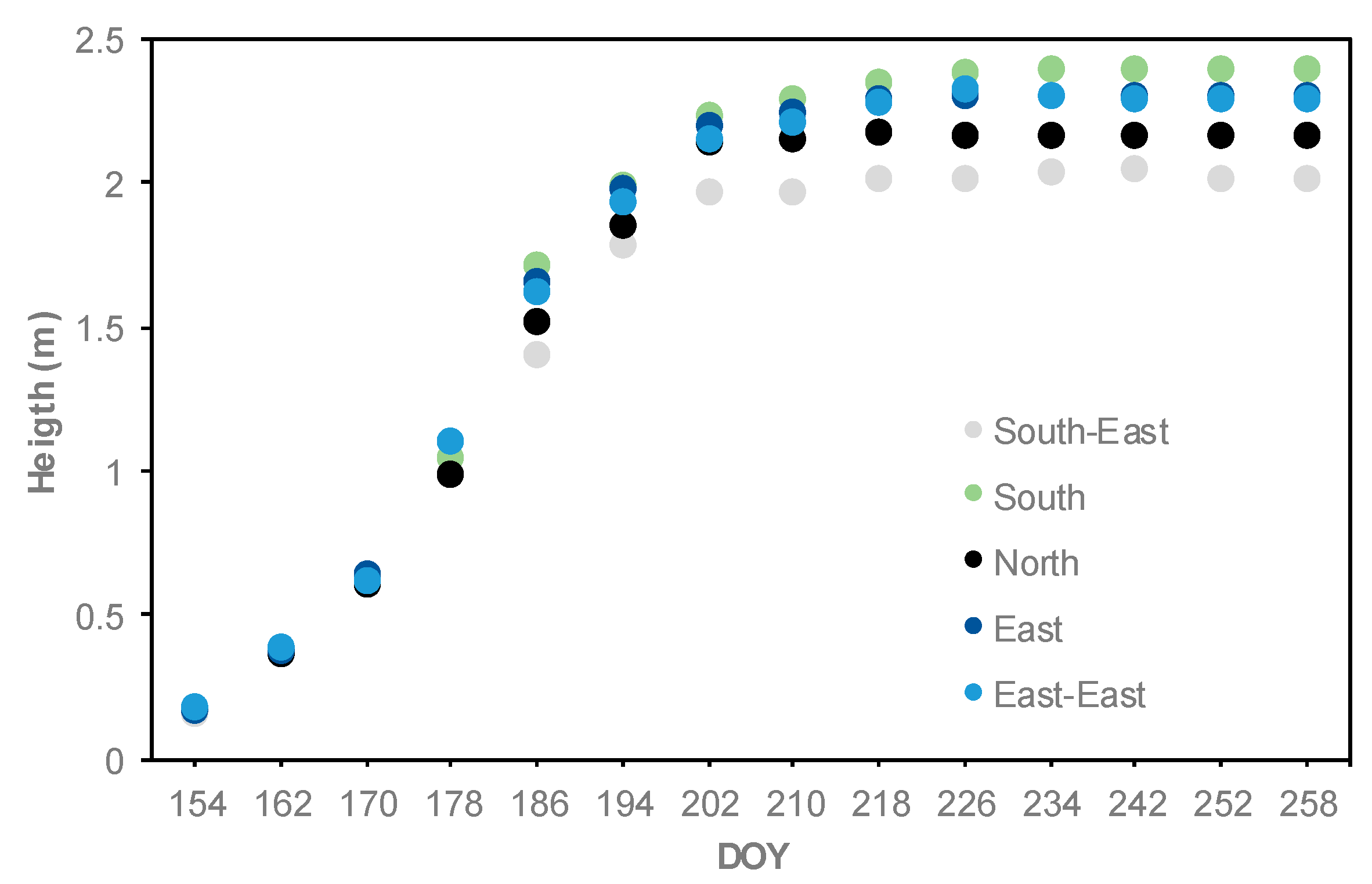


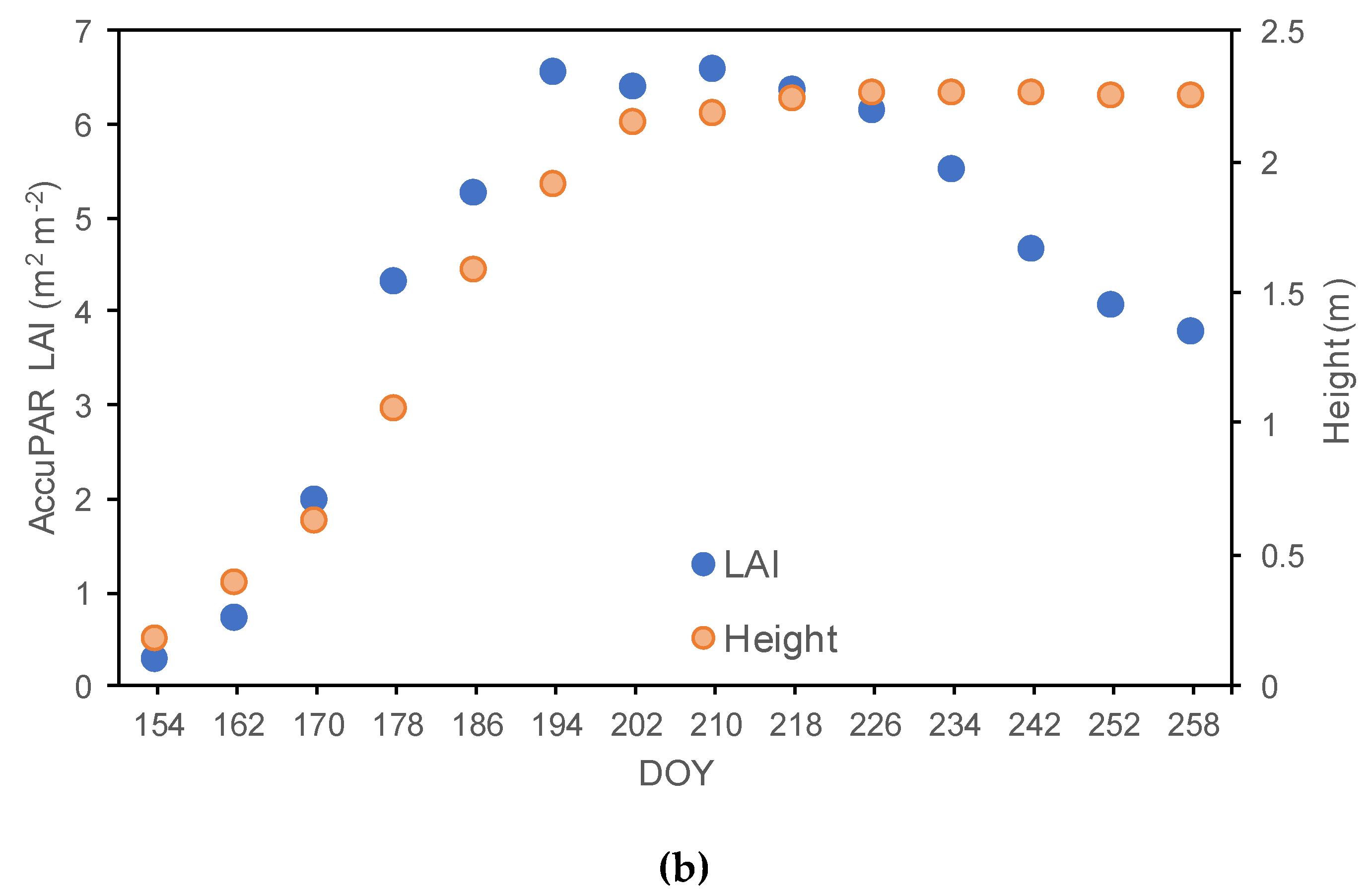


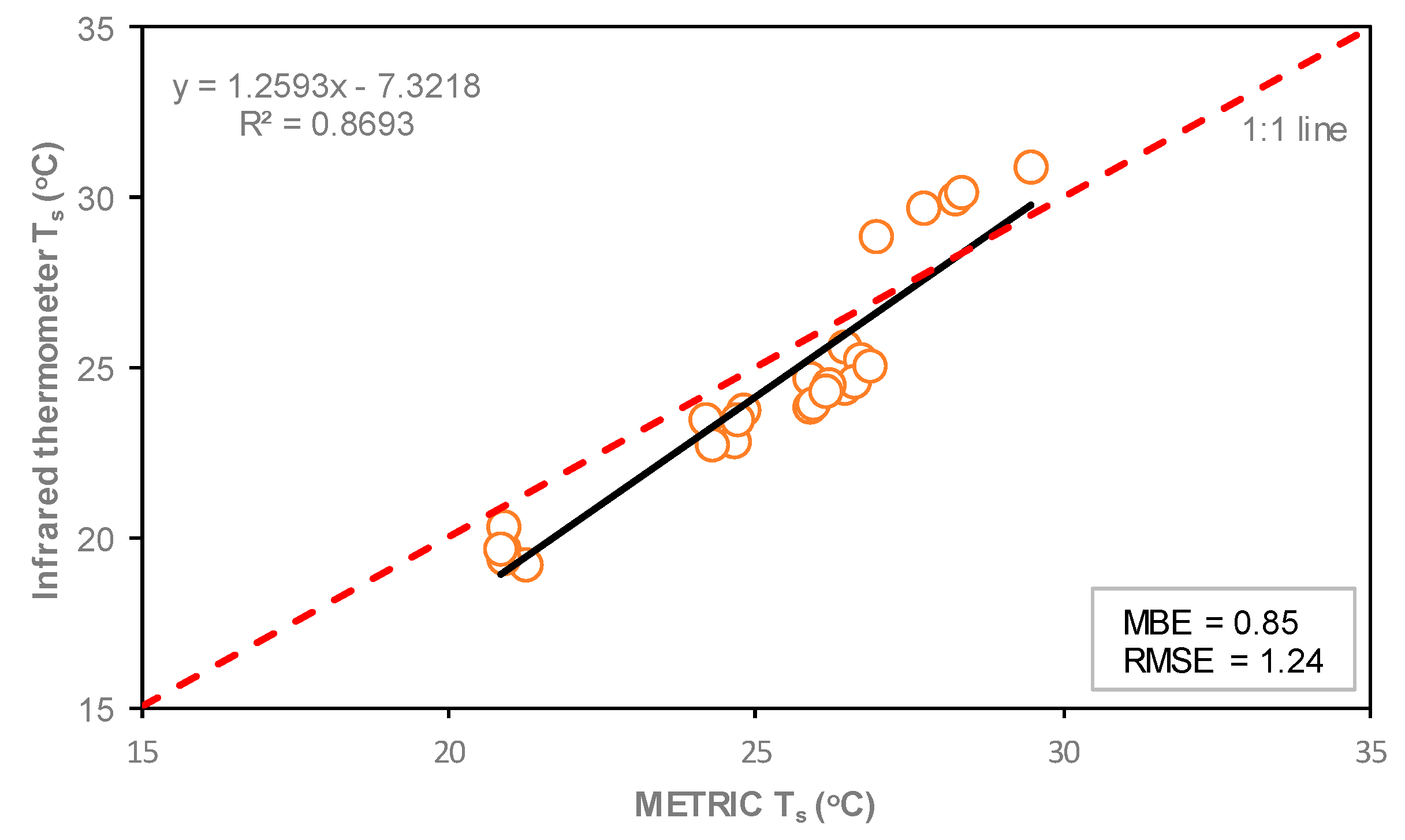
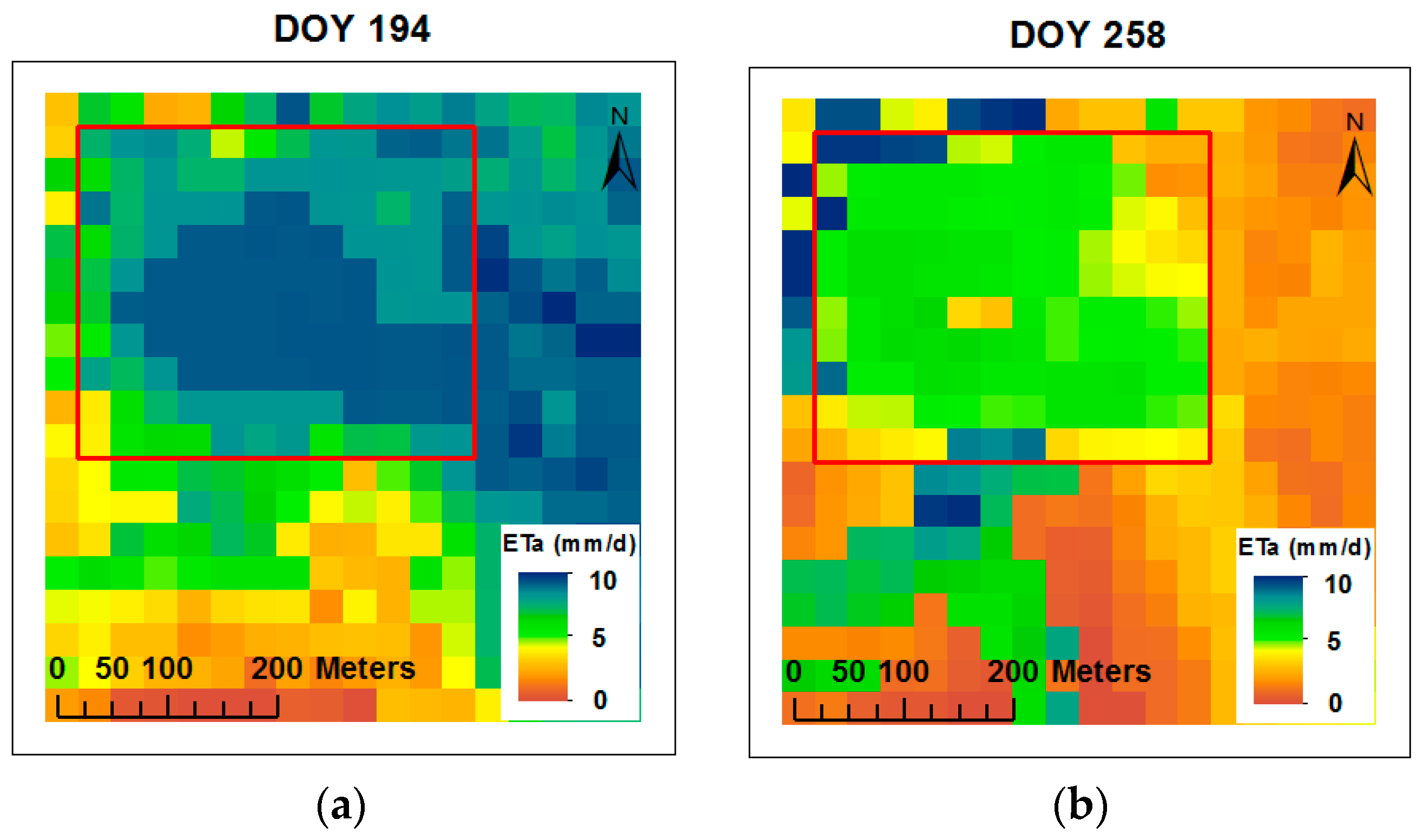
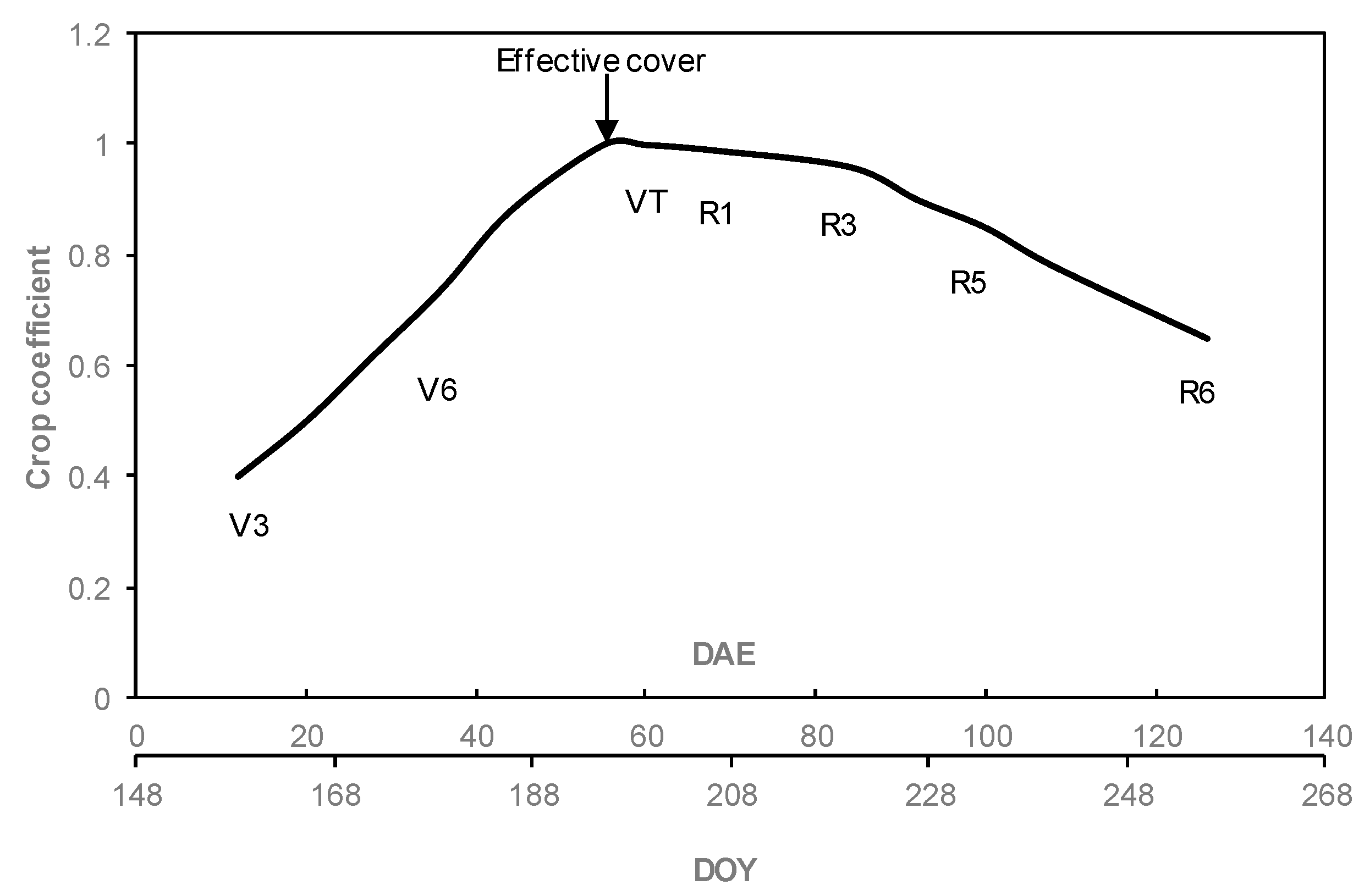
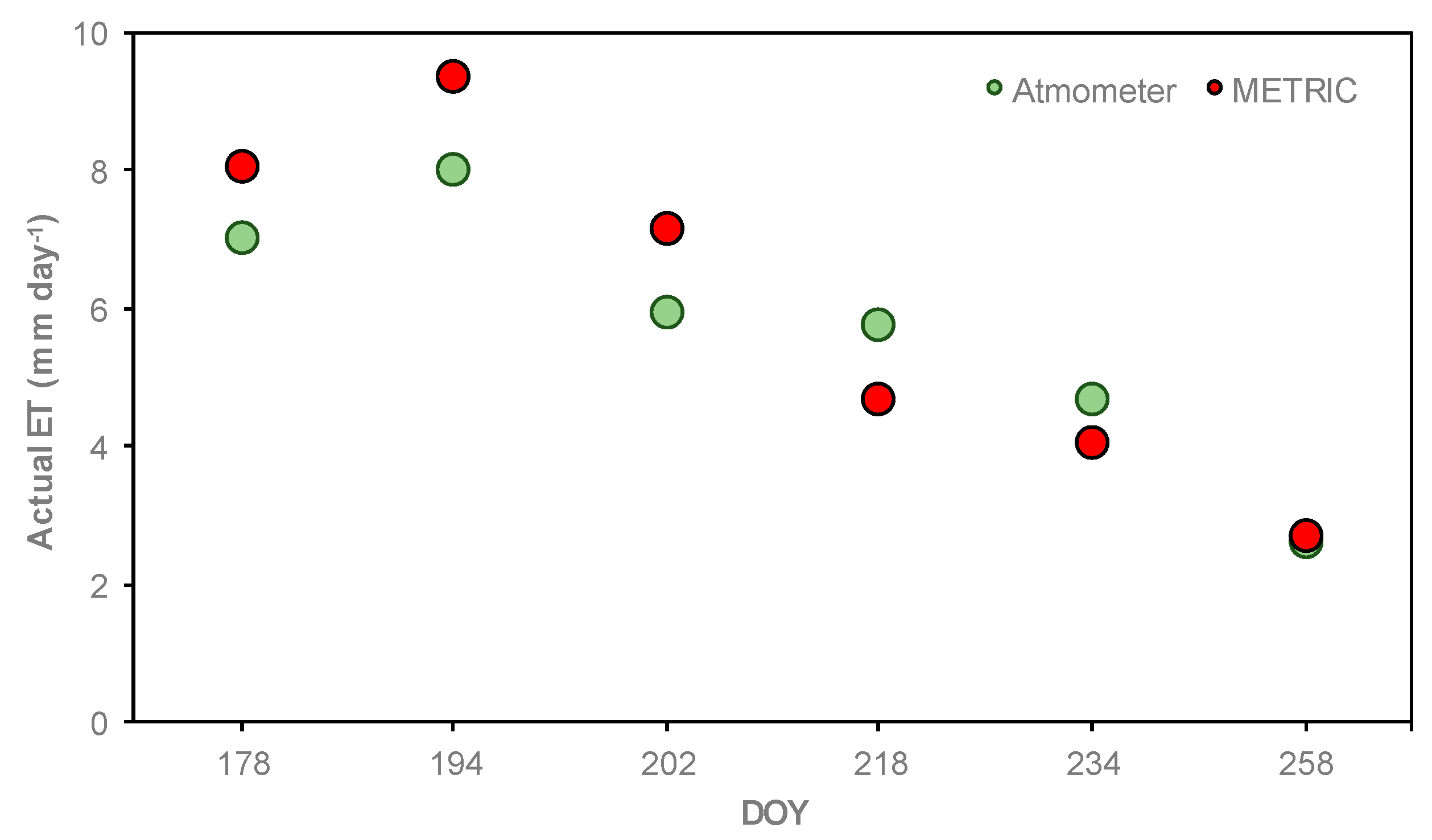

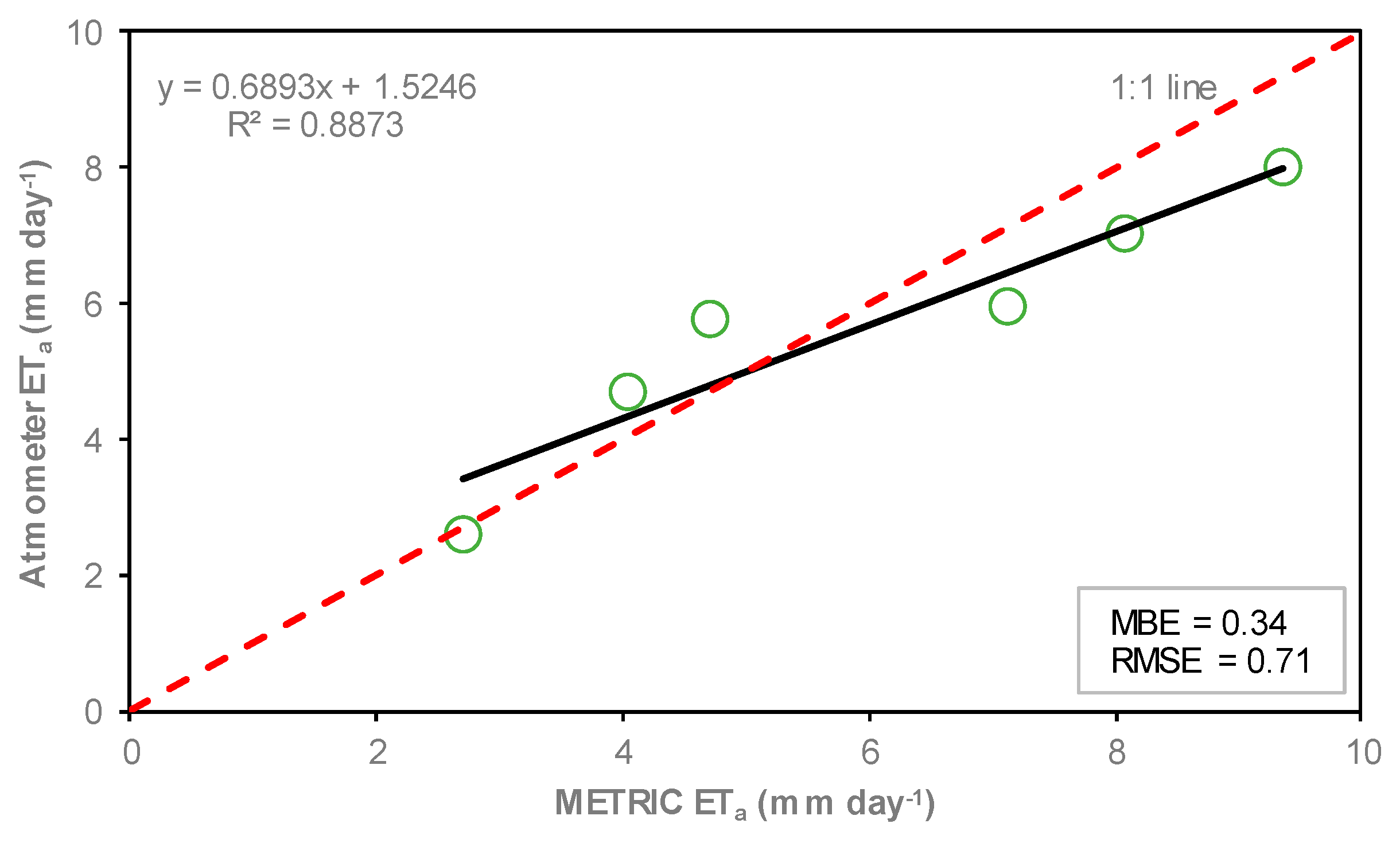
| Site | Latitude (N) | Longitude (W) | Altitude (m) | Soil Texture | FC (m3 m−3) | WP (m3 m−3) |
|---|---|---|---|---|---|---|
| South-east (S-E) | 43° 56′ 20.7″ | 96° 45′ 11.6″ | 495 | silt clay loam | 0.33 | 0.19 |
| South (S) | 43° 56′ 20.8″ | 96° 45′ 15.7″ | 493 | silt loam | 0.31 | 0.15 |
| North (N) | 43° 56′ 27.6″ | 96° 45′ 19.5″ | 501 | silt clay loam | 0.33 | 0.19 |
| East (E) | 43° 56′ 25.6″ | 96° 45′ 11.5″ | 493 | silt loam | 0.31 | 0.15 |
| East-east (E-E) | 43° 56′ 23.0″ | 96° 45′ 10.0″ | 492 | silt loam | 0.31 | 0.15 |
| DOY | Acquisition Dates | Satellite | Path/Row | Overpass Time (Local) |
|---|---|---|---|---|
| 178 | 06/26/16 | Landsat 7 | 29/29 | 11:13:56 a.m. |
| 194 | 07/12/16 | Landsat 7 | 29/29 | 11:13:55 a.m. |
| 202 | 07/20/16 | Landsat 8 | 29/29 | 11:11:21 a.m. |
| 218 | 08/05/16 | Landsat 8 | 29/29 | 11:11:24 a.m. |
| 234 | 08/21/16 | Landsat 8 | 29/29 | 11:11:30 a.m. |
| 258 | 09/14/16 | Landsat 7 | 29/29 | 11:14:05 a.m. |
| LAI (m2 m−2) | ||||||||||
|---|---|---|---|---|---|---|---|---|---|---|
| DOY | South-East | South | North | East | East-East | |||||
| MET | AccuP | MET | AccuP | MET | AccuP | MET | AccuP | MET | AccuP | |
| 178 | 3.6 | 4.5 | 4.0 | 4.8 | 3.8 | 4.7 | 4.1 | 5.0 | 3.8 | 4.9 |
| 194 | 4.6 | 5.9 | 6.0 | 7.0 | 4.7 | 6.6 | 5.5 | 6.8 | 5.3 | 6.4 |
| 202 | 6.0 | 5.8 | 6.0 | 6.7 | 6.0 | 6.4 | 6.0 | 6.8 | 6.0 | 6.1 |
| 218 | 6.0 | 5.9 | 6.0 | 7.0 | 6.0 | 5.9 | 6.0 | 6.7 | 6.0 | 6.3 |
| 234 | 6.0 | 4.7 | 6.0 | 6.2 | 6.0 | 5.7 | 6.0 | 5.2 | 6.0 | 5.7 |
| 258 | 1.3 | 3.0 | 2.6 | 3.7 | 2.4 | 3.4 | 2.3 | 3.3 | 2.5 | 3.8 |
| Ts (°C) | ||||||||||
|---|---|---|---|---|---|---|---|---|---|---|
| South-East | South | North | East | East-East | ||||||
| DOY | MET | IRT | MET | IRT | MET | IRT | MET | IRT | MET | IRT |
| 194 | 26.4 | 25.6 | 26.4 | 24.5 | 25.9 | 24.7 | 25.9 | 23.9 | 25.9 | 24.0 |
| 202 | 29.5 | 31.0 | 28.2 | 30.1 | 27.7 | 29.7 | 26.9 | 28.9 | 28.3 | 30.2 |
| 218 | 26.7 | 25.3 | 26.6 | 24.6 | 26.9 | 25.1 | 26.2 | 24.5 | 26.1 | 24.4 |
| 234 | 24.8 | 23.8 | 24.6 | 22.8 | 24.7 | 23.5 | 24.2 | 23.5 | 24.2 | 22.8 |
| 258 | 20.9 | 19.7 | 21.2 | 19.2 | 20.9 | 19.4 | 20.9 | 20.4 | 20.8 | 19.7 |
| METRIC ETa (mm day−1) | ||||||
|---|---|---|---|---|---|---|
| DOY | South-East | South | North | East | East-East | Average |
| 178 | 7.98 | 8.06 | 7.68 | 8.45 | 8.22 | 8.08 |
| 194 | 9.40 | 9.41 | 8.87 | 9.72 | 9.45 | 9.37 |
| 202 | 7.16 | 7.08 | 7.10 | 7.14 | 7.26 | 7.15 |
| 218 | 4.63 | 4.63 | 4.56 | 4.82 | 4.92 | 4.71 |
| 234 | 3.91 | 3.96 | 3.93 | 4.23 | 4.23 | 4.05 |
| 258 | 2.69 | 2.87 | 2.75 | 2.60 | 2.67 | 2.72 |
© 2019 by the authors. Licensee MDPI, Basel, Switzerland. This article is an open access article distributed under the terms and conditions of the Creative Commons Attribution (CC BY) license (http://creativecommons.org/licenses/by/4.0/).
Share and Cite
Reyes-González, A.; Kjaersgaard, J.; Trooien, T.; Reta-Sánchez, D.G.; Sánchez-Duarte, J.I.; Preciado-Rangel, P.; Fortis-Hernández, M. Comparison of Leaf Area Index, Surface Temperature, and Actual Evapotranspiration Estimated Using the METRIC Model and In Situ Measurements. Sensors 2019, 19, 1857. https://doi.org/10.3390/s19081857
Reyes-González A, Kjaersgaard J, Trooien T, Reta-Sánchez DG, Sánchez-Duarte JI, Preciado-Rangel P, Fortis-Hernández M. Comparison of Leaf Area Index, Surface Temperature, and Actual Evapotranspiration Estimated Using the METRIC Model and In Situ Measurements. Sensors. 2019; 19(8):1857. https://doi.org/10.3390/s19081857
Chicago/Turabian StyleReyes-González, Arturo, Jeppe Kjaersgaard, Todd Trooien, David G. Reta-Sánchez, Juan I. Sánchez-Duarte, Pablo Preciado-Rangel, and Manuel Fortis-Hernández. 2019. "Comparison of Leaf Area Index, Surface Temperature, and Actual Evapotranspiration Estimated Using the METRIC Model and In Situ Measurements" Sensors 19, no. 8: 1857. https://doi.org/10.3390/s19081857





